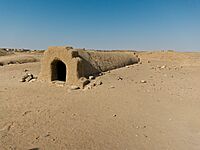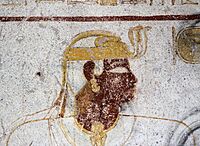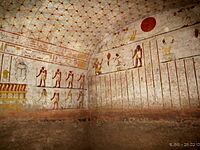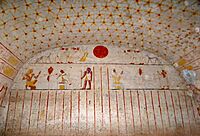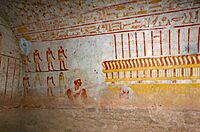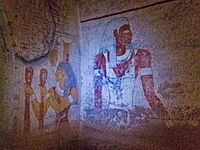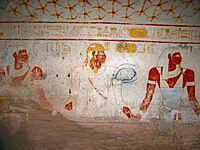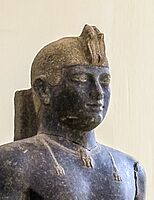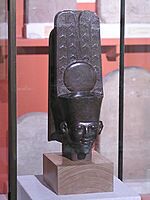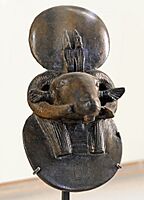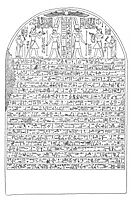Tantamani facts for kids
Quick facts for kids Tantamani |
|||||
|---|---|---|---|---|---|
| Kushite King of Napata | |||||
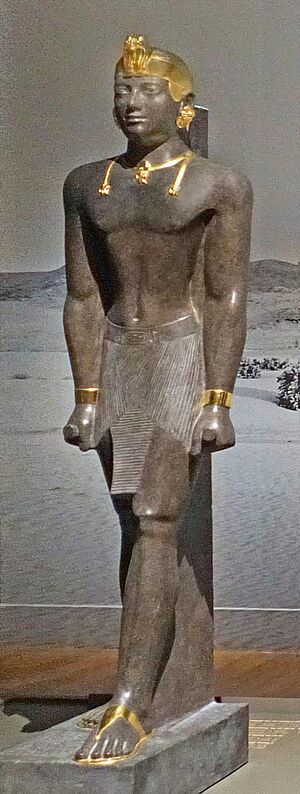
Statue of Kushite ruler and last pharaoh of the 25th Dynasty, Tantamani (Louvre Museum, reconstruction through color-pigment analysis)
|
|||||
| Predecessor | Taharqa | ||||
| Successor | Atlanersa | ||||
| Burial | El-Kurru (K. 16) | ||||
| Spouse | Piankharty, [..]salka, possibly Malaqaye, | ||||
| Issue | Possibly Atlanersa, Queen Yeturow, Queen Khaliset | ||||
|
|||||
| Father | Shabaka (or Shebitku?) | ||||
| Mother | Queen Qalhata | ||||
Tantamani (also known as Tanutamun or Tanwetamani) was an important ruler from the ancient Kingdom of Kush. This kingdom was located in what is now Northern Sudan. Tantamani was also the last pharaoh (king) of the Twenty-fifth Dynasty of Egypt. This means his family ruled both Kush and Egypt for a time. His royal name was Bakare, which meant "Glorious is the Soul of Re" – a name honoring the sun god Re. He died in 653 BC.
Contents
Who Was Tantamani's Family?
Tantamani was the son of King Shabaka. He was also the nephew of the pharaoh who ruled before him, Taharqa. Some old records from Assyria (another ancient empire) say that Tantamani's mother was Queen Qalhata. She was Taharqa's sister. This information helps us understand the family connections of the Kushite rulers.
Tantamani's Fight with Assyria
After the Assyrians had taken control of Egypt and left, Tantamani decided to invade. He wanted to bring his family back to power in Egypt. Tantamani marched his army north along the Nile River from Nubia (Kush). He successfully took back all of Egypt, including the important city of Memphis. During his campaign, the Assyrian representative and a local king named Necho I were killed.
This led to a big conflict with the powerful Assyrian king Ashurbanipal in 663 BCE. Ashurbanipal brought a very strong army back to Egypt. They joined forces with Psamtik I's army, which included skilled fighters from a place called Caria. They fought a major battle near Memphis. Tantamani was defeated and had to escape to Upper Egypt.
Forty days later, Ashurbanipal's army reached the city of Thebes. Tantamani had already left Thebes for a place called Kipkipi. The Assyrians then took over Thebes. They heavily plundered the city, taking many valuable items. This event, known as the Sack of Thebes, was a huge deal in the ancient world.
The Assyrians took a lot of treasure from Thebes, including:
- Gold and silver
- Precious stones and rich cloth
- Horses and exotic animals
- Two tall stone monuments called obelisks, covered in a shiny metal called electrum. These obelisks weighed a lot!
Ashurbanipal wrote about his victory:
This city, the whole of it, I conquered it with the help of Ashur and Ishtar. Silver, gold, precious stones, all the wealth of the palace, rich cloth, precious linen, great horses, supervising men and women, two obelisks of splendid electrum, weighing 2,500 talents, the doors of temples I tore from their bases and carried them off to Assyria. With this weighty booty I left Thebes. Against Egypt and Kush I have lifted my spear and shown my power. With full hands I have returned to Nineveh, in good health.
The taking of Thebes was a very important event. It even gets mentioned in ancient texts like the Book of Nahum and the Book of Isaiah. These texts describe the city's fall and the people being taken away.
This Assyrian victory effectively ended the rule of the Nubian (Kushite) kings over Egypt. Although Tantamani was still recognized as ruler in Upper Egypt for a few more years, Psamtik I eventually took full control of Thebes in 656 BCE. This peaceful takeover united all of Egypt under Psamtik I, starting the Twenty-sixth Dynasty of Egypt.
Tantamani's Later Years
After losing Egypt, Tantamani ruled only his homeland, Nubia (the Kingdom of Kush). He passed away in 653 BC. His successor was Atlanersa, who was a son of Taharqa. Tantamani was buried in his family's burial ground at El-Kurru. In 2003, an archaeologist named Charles Bonnet found a statue of Tantamani at a place called Kerma.
Tantamani's Tomb at El-Kurru
Tantamani's tomb was built under a pyramid that no longer exists today. Only the entrance and the burial chambers remain. These chambers are decorated with beautiful paintings on the walls.
Artifacts from Tantamani's Time
Many artifacts have been found that tell us more about King Tantamani and his reign. These include statues and other objects.
-
Tantamani statue, Toledo Museum of Art
-
Painting of Tantamani, in Thebes
-
Statuette of god Amon dedicated by Tantamani
-
Head of Amon-Ram dedicated by Tantamani, Musée du Louvre
See also
- List of monarchs of Kush




